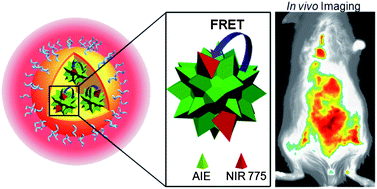Near-infrared fluorescence amplified organic nanoparticles with aggregation-induced emission characteristics for in vivo imaging†
Abstract
Near-infrared (NIR) fluorescence signals are highly desirable to achieve high resolution in biological imaging. To obtain NIR emission with high brightness, fluorescent nanoparticles (NPs) are synthesized by co-encapsulation of 2,3-bis(4-(phenyl(4-(1,2,2-triphenylvinyl)phenylamino)phenyl)fumaronitrile (TPETPAFN), a luminogen with aggregation-induced emission (AIE) characteristics, and a NIR fluorogen of silicon 2,3-naphthalocyanine bis(trihexylsilyloxide) (NIR775) using 1,2-distearoyl-sn-glycero-3-phosphoethanolamine-N-[methoxy(polyethylene glycol)-2000] as the encapsulation matrix. The good spectral overlap between the emission of TPETPAFN and the absorption of NIR775 leads to efficient energy transfer, resulting in a 47-fold enhancement of the NIR775 emission intensity upon excitation of TPETPAFN at 510 nm as compared to that upon direct excitation of NIR775 at 760 nm. The obtained fluorescent NPs show sharp NIR emission with a band width of 20 nm, a large Stokes shift of 275 nm, good photostability and low cytotoxicity. In vivo imaging study reveals that the synthesized NPs are able to provide high fluorescence contrast in live animals. The Förster resonance energy transfer strategy overcomes the intrinsic limitation of broad emission spectra for AIE NPs, which opens new opportunities to synthesize organic NPs with high brightness and narrow emission for potential applications in multiplex sensing and imaging.


 Please wait while we load your content...
Please wait while we load your content...